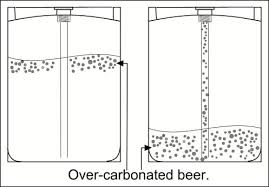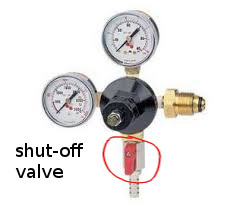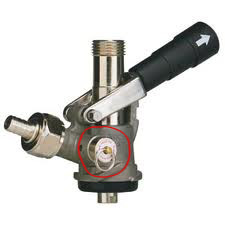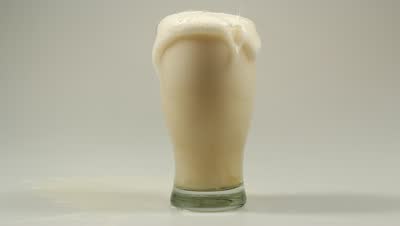Most domestic beers (and most imports) are designed by the brewery to be served with just a
small bit of carbonation. We can maintain this balance of carbonation with our pressure gauge
set to 12 PSI. But if your secondary (step-down) regulator is set a bit higher, maybe 15 PSI or
more of straight CO2, then you are slowly over-carbonating your keg. This is not usually an
issue if the keg is used within a few days. But for kegs that sit tapped for weeks at a time or
longer this can become a concern.

You can see above that you draw your beer
from
the bottom of the keg, so you don't begin to get the lighter,
foamier
over-carbonated beer until you reach the last of the keg.
Ideally, we keep it from getting
over-carbonated in the first
place. But if it does happen, there are a couple of tricks
you
can use.
Here's what you can do:
1. Keep the beer cold. The colder
the better.
34 degrees is better than 38 for reducing foam
in
slightly
overcarbonated beer
2. Make sure the regulator that
controls the pressure to the keg
is set no higher than 12 PSI.
3 . De-gas the keg.
-
Shut the gas off to the keg at the regulator
(hopefully there is a shut-off valve)

-
Open the safety release valve on the keg to release the gas

The safety release is circled in red, pull the ring out to release
the head pressure on the keg. -
Shake the keg for 15 seconds
-
Wait 3 minutes, then open the safety release valve again to vent
the carbonation you just stirred up. -
Turn the gas back on to the keg at the regulator.
Do not make the mistake of trying to adjust the pressure of the
regulator down, because the reduced
pressure will allow the
Carbonation in the slightly over-carbonated beer to "Break out"
of
the
beer and foam in the line, just behind any connections or the
shank of
the faucet.
This will make the problem worse, not better.
To make sure your regulator is set to
maintain the perfect, ideal conditions for your beer,
call one of our
Draught Beer specialists to come give you a free estimate for
the
repair
or installtion of a Beer Dispensing System. Intalls
Repairs
The
best
way to fight this is to make sure all conditions are as close to
ideal as we can realistically make them. The lines are
straight
or smoothly curved (no "elbow" joints), the pressure is just
high
enough to dispense smoothly, not too much. The lines are
clean,
the beer is cold, and the lines are being cooled, chilled, or at
least
insulated all the way to the dispenser. Remember, if
the
beer warms it will release the co2 gas.. so if it gets warm in
the
tubing on the way from the back room or beer cooler out to the
bar,
then it will foam IN THE LINE, and this will cause your beer at
the
dispenser to come out alternately clear and foamy, depending on
how
many "hot spots" you have along the line.
Call 713-944-7900 to schedule a Service Call.

